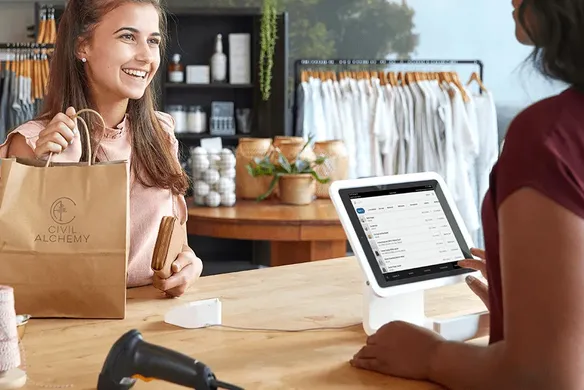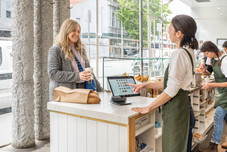Table of contents
There are several ways that customers interact with your business. Each one is an opportunity for you to nurture their interactions towards a sale, commonly known as customer touch points. Optimising your customer touchpoints can result in increased sales, more revenue and stronger brand loyalty. Win, win!
What are customer touch points?
The meaning of a customer touch point can be described as every interaction a customer has with your business from initial learnings, through to repeat sales. The second a customer starts searching for products and services, there’s an opportunity for them to engage with your brand. Throughout the customer journey there are several touchpoints that a customer may experience. For example, clicking on a Facebook ad and being taken to a landing page on your website involves two touch points. They also experience many touch points when they enter and then purchase an item in-store. There are also post-sale touchpoints, such as marketing emails, returns and customer support.
For ease of information we will discuss touch point examples below,breaking them into three distinct categories:
- Before sale
- During sale
- After sale
This represents the customer journey and how customers engage with your brand.
Benefits of understanding customer touch points
Understanding your customer touch points is crucial for the following reasons:
- Generating more sales – If you get your touch points right, you can nurture more customers towards a sale. Think, every touch point is a conversion opportunity.
- Building brand loyalty – Customers have several touch points between discovering your business and becoming a loyal customer. Great experiences at every touch point encourage brand loyalty over time
- Touch points provide great data – You can measure the success of your touch points along the way, giving you insight into what your customers are looking for.
20 customer touch point examples
The customer journey looks different for every business, so your customer touch points may not be the same as your competitors. Ultimately, it comes down to how you market your business. A single customer will never experience every one of these touch points, but they will certainly engage with your brand through many of these methods.
Here are 20 of the most common customer touch points that may apply to your business.
Before purchase
Online advertising
Customers are exposed to ads on search engines such as Google. Alternatively, they may see pop-up or banner ads for your brand on other websites.
Social media
Your audience may be shown social media ads, but they can also engage with your social media accounts directly. This is a common way for people to research products and services before buying.
SEO
Companies invest in SEO to ensure they rank well on search engines for keywords relevant to their products and services. Every time a customer clicks a link to your page on Google, your SEO is working.
Video content
Video is the most consumed form of media online, so if you’re creating videos you’ve got a strong opportunity to capture your audience’s attention.
Chat bots
Chat bots and other self-service systems are becoming more and more common. They’re a terrific chance to provide a positive experience for your customers, so you should make sure your self-service options are high-quality.
Blogs and articles
Publishing blogs and articles not only helps with SEO, but you can share the information on social media. Well-written content establishes you as an authority and increases customer confidence in your business.
Print media
It may be less common today, but print media such as brochures, flyers and newspaper ads are still a great way to connect with an audience.
Business website/online store
Most roads should lead back to your website. Social media links, Google ads, even organic search results. Using a tool like Square Online to build an easily accessible website or e-commerce store is one of your best chances to provide customers with a positive experience.
Local directory / Google My Business
With so many customers searching for products and services nearby, particularly on mobile search, it pays to ensure your Google My Business profile is set up properly. This and other industry directories give you a great opportunity to connect with a new audience.
Online appointment booking
Many customers prefer to make appointments online. Making this process easy and intuitive by using Square Appointments ensures that customers don’t back out of a booking halfway through.
During purchase
Product reviews
We could include this in the ‘before purchase’ section because customers research your business using reviews. But, it can also be in the ‘during purchase’ section because people using your eCommerce store may still be deciding between two products as they’re about to buy. It can also fall in the ‘after purchase’ section, because you can encourage satisfied customers to leave a positive review. What are we saying? Reviews are important!
Point of sale
Whether it’s online or in-store, the Point of Sale experience should be a positive one. Friendly customer service plays a big role here, but so does the technology you use. Square POS makes it easy to manage all of your sales, both online and in-person.
Phone contact
If your business takes bookings or purchases over the phone, this is another touchpoint that can either drive people mad, or turn them into happy returning customers.
Online payment processing
If you’re experiencing a lot of abandoned shopping carts in your ecommerce store, there may be a problem with your online payment processing. Square Online Payments gives customers plenty of payment options, and makes checkout easy, reducing the number of missed sales.
After purchase
Customer feedback
Successful companies use feedback as a way of improving their services and delivering what customers want.
Marketing emails
Sending emails to your existing customer list is a great way to generate more sales and increase brand loyalty. Plus, you’ve already got those customers interested in your business, so it’s a cost-effective way of generating sales.
Billing
Receiving an invoice is another touchpoint for your customers. While nobody likes paying bills it’s important to ensure the process is as easy as possible for your customers by offering them multiple payment options.
Customer support
In business, you’ll be lucky if you never have post-sale enquiries, complaints or returns. It’s part of operating a business and the way you manage customer support can have an impact on whether customers return or go elsewhere in future.
Community management
Think of your business like an online community. Particularly on social media, customers enjoy interacting with your brand in an organic way. They might share their experiences and tag you, or they may even seek the resolution of a complaint. Managing this online community with quick responses goes a long way in building brand loyalty.
Customer loyalty programs
Operating a customer loyalty program gives you multiple touch points over a long period of time. Whether it’s advertising special offers, or providing customer loyalty benefits, loyalty programs make it easy to reward your brand fans!
3 Tips on how to identify customer touch points
A problem many businesses face is identifying their customer touch points. We operate in a world where you need to provide a genuine omnichannel experience for customers – online, phone, social media and retail outlets. This is a great approach for reaching your audience far and wide, but it does make it tricky to keep on top of everything. Here are some tips to identify your customer touch points.
1. Consider your marketing efforts
A great place to start is by looking at your marketing efforts. All of these will create a customer touch point somewhere in the funnel, such as a Google ad, social media post, newspaper ad and even blogs for your website. List all of the places you’re investing in marketing and you will have identified the touch points you’re currently investing money in.
2. Put yourself in your customers’ shoes
Of course, paid and organic marketing is only a fraction of the touch points you will create along the way, so you need to put yourself in your customer’s shoes. Ask yourself a few key questions:
- Where do customers hear about you? Social media? Recommendations?
- Where are they researching your business?
- How do customers contact you?
As you’ve seen above, there are countless touch points created in the customer journey, and by seeing things through the eyes of your customers, you’ll be able to identify most of them.
3. Map out your customer touch points
Finally, the best way to develop a clear picture of all your touch points is to do some customer journey mapping. This process maps out every interaction a customer has with your business from the moment they search for your products and services, all the way through to your after-sales support programs. A great way to break up these interactions is by grouping them into:
- Awareness
- Consideration
- Sale
- Post-sale
By clearly understanding all of your customer touch points, you can work on optimising each of them and increase your chances of a sale!
![]()










